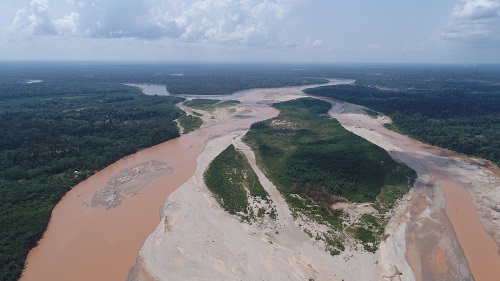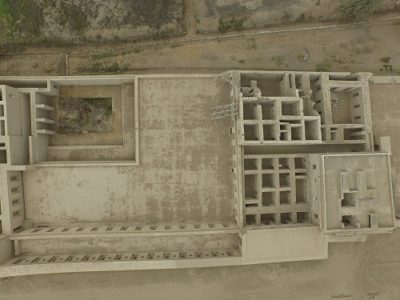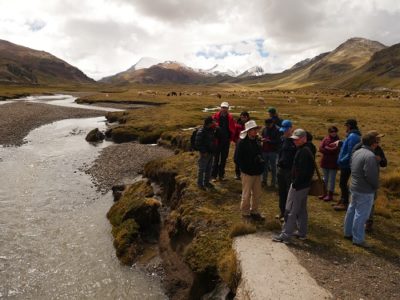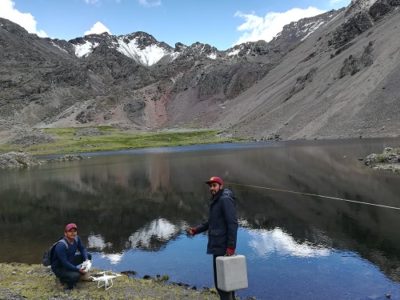
TaLGEnTox: Analysis and management of the risks associated with the presence of cyanotoxins in waters and development of clean technologies for their elimination: towards an improvement in public health
Funded by CYTED and Fondecyt. 30,000 EUR. @UTEC: Dr. Patrick Venail (PI), Dra. Monica Santa-Maria (co-PI)
The processes of eutrophication and climate change are generating the massive proliferation of cyanobacteria and, therefore, of cyanotoxins in waters bodies of almost all ecosystems and climates on Earth. Regarding this situation, the project proposes the development of a sustainable risk management system for the exposure of cyanotoxins content in water, including a proposal of efficient, environmentally friendly and economic treatments to eliminate these compounds. The achievement of this objective would guarantee an improvement in the quality of the water and, therefore, of public health, favoring the sustainable growth of the population.

Impacts of alluvial mining in the Madre de Dios Basin: physical effects and mitigation planning
Funded by the NASEM and USAID. 100,000 USD. @UTEC: Dr. Mónica Moreno Brush (PI), Dr. Daniel Horna, @CINCIA: Dr. Luis Fernández (co-PI), Dr. Julio Aráujo, Dr. César Ascorra, Dr. Claudia Vega, @USDA: Dr. Eddy Langendoen
By combining state-of-the-art techniques in field measurement, remote sensing, and mathematical modeling of riverine processes, this proposal explores the interactions between flow, sediment transport, and channel change in rivers in association with the distribution of mercury along the food chain. The outcomes will provide useful insights for land managers and decision-makers on river morphodynamics and function, a crucial gap in the understanding of rivers, currently a critical national priority.
More information in the official webpage: https://sites.google.com/utec.edu.pe/rivermining/

Analysis of the hydraulic system of the network of channels and ponds in the Acllawasi of the Pachacamac complex
Funded by UTEC Seed Fund. 20,000 PEN. @UTEC: Dr. Daniel Horna (PI), @Ministry of Culture @Museo de Pachacamac
The objective of this project is to describe the functionality of the network of channels and ponds found in the Acllawasi area (Incan-design house for selected women) at the Sanctuary of Pachacamac using a combination of numerical models, in order to provide information about undiscovered channels based on the connectivity of channel network.

PEGASUS: Producing EnerGy and preventing hAzards from sUrface water Storage in Peru
Funded by Newton-Paulet Fund, through NERC and Fondecyt. 1'500,000 PEN. @UTEC: Dr. Daniel Horna (PI), Dr. Pedro Rau (co-PI). @University of Leeds: Dr. Duncan Quincey, @UNSAAC @PUCP @CARE Peru
PEGASUS will assess the opportunities and threats that rapidly changing landscapes and natural resources will bring to people and businesses from the three glacial ranges of the Peruvian Andes: Urubamba, Vilcabamba and Vilcanota. This evaluation will integrate consultations with the government (GORECC), a large hydroelectric power company (EGEMSA) and, crucially, the communities that live in the basins we have studied. The following recommendations will provide information on the sustainability of current and future hydroelectric schemes, how to manage water use in the coming decades, and formulate policies that reflect the needs of all stakeholders, and the potential dangers that unstable mountain environments can represent for the livelihood in future years. The main objective is to provide the basic science necessary to maximize opportunities and minimize the risks presented by the future storage of surface water in the glacial basins of the Peruvian Andes.

WateR security And climate cHange adaptation in PerUvian glacier-fed river basins (RAHU)
Funded by Newton-Paulet Fund, through NERC and Fondecyt. 1'500,000 PEN. @UTEC: Dr. Pedro Rau (PI). @Imperial College London: Dr. Wouter Bouytaert, @UNSAAC @Senamhi @CONDESAN
The aim of this project is focused on monitoring of water resources as an innovative approach to increase and transform knowledge of physical processes and the application of modeling in water resources. The set of these data produced will allow the construction of an integrated model of water supply and demand assessment, evaluating human vulnerability in order to develop local adaptation strategies in the long term. The formulation of these adaptation measures includes novel approaches such as the use of nature-based solutions and the restoration of ancestral practices of "sowing and harvesting" water, thus providing both the scientific basis and the operational tools for decision making in Peru within the new legal framework of water resources.

Design and implementation of hydrological monitoring systems for the Saywapata amuna (San Pedro de Casta), and the infiltration ditches in Canchamoya (San Mateo)
Funded by The Nature Conservancy and Aquafondo. 60,000 EUR. @UTEC: Dr. Pedro Rau (co-PI)
The main objective of this project is to generate information on the hydrological system in the sub-basin of the Santa Eulalia River and to describe the efficiency of the hydraulic system of amunas and infiltration ditches, as part of conservation practices based on ecosystems that have a positive impact in the management and conservation of water sources for the use of the population. The project also includes the social participation component, which includes the organization of participatory workshops with community members, whose objective is to provide training on topics related to the quality and contamination of surface water, groundwater, bioindicators and hydrological monitoring.

Portfolio of ecosystem services projects for the Lima basins: Chillón, Rímac, Lurín, and Alto Mantaro
Funded by The Nature Conservancy. 60,000 USD. @UTEC: Dr. Pedro Rau (co-PI), @CIAT
The main objective is the formulation of a portfolio of activities for the conservation and restoration of the green infrastructure of the Chillón, Rímac, Lurín and Alto Mantaro basins in order to maximize the supply of hydrological ecosystem services and the preparation of investment cards.

